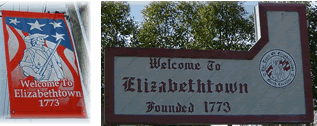 |
||||
|
|
||||
 Transportation and communications were key factors in the settlement and growth of Bladen County. In the early days of settlement, rivers were the only effective means of transporting goods to any extent; therefore the settlers occupied the lands along the Cape Fear River and the South River. The Cape Fear, a much larger river, attracted more of the early settlers, yet along both rivers homes were built and plantations were developed. Attempts were made in 1732 and 1733 to break away from New Hanover Precinct, but Bladen Precinct finally became its own entity on November 11, 1734, encompassing a very large area that was later broken into scores of other counties. In 1738, all precincts were renamed as counties. Also in 1738, the first court house was built in Elizabeth, about three miles upriver from the present-day town and county seat of Elizabethtown, which was moved to its present location in 1773 and incorporated. The site of Elizabeth Town was a hundred-acre tract belonging to Isaac Jones where he was already operating a tan yard, mill, and bark house, as well as a ferry. It was a "healthy, pleasant situation, well-watered and commodious for commerce," and was chosen at the instigation of persons interested in promoting local trade and river traffic. An Act of the colonial House of Burgesses transferred to Walter Gibson, William Salter, James White, James Bailey, and Benjamin Humphrey, as Directors and Trustees, the title to the 100 acres. These men constituted a self-perpetuating body with the authority for "Designing, building, and carrying on the said Town." They were empowered to designate a place on the river for a public landing and to reserve three acres for a market and other public buildings. As much as necessary of the remainder of the tract was to be divided into 120 half-acre lots, along with appropriate streets, lanes, and alleys. As soon as the town was laid out, a map was to be prepared and each lot was to be identified by number. The Directors were to accept subscriptions and when commitments for as many as 70 lots had been received, a drawing was to be held to determine the owners of each specific lot. The price for each lot was forty shillings - thirty shillings to go to Isaac Jones and the balance to be used by the Directors in paying the costs of laying out the town and for other public purposes. Each person, after receiving title for their lot, was required within a period of three years, to build a house at least sixteen feet square, or proportionately larger, if two or more contiguous lots were used for a single dwelling. In the same Act, Thomas Owens, James White, William McRee, Walter Gibson, and William Salter were named commissioners with authority to enter into a contract of "building a court house and finishing the Prison and Work House" on the area to be set aside for public buildings. The necessary funds were to be raised by a levy of tax on the taxables of the county for three years. Until the new court house could be contracted, future sessions of the county court were to be held "at some convenient House in the Town of Elizabeth." It was a long time before a court house was finally built, mostly thanks to the American Revolution. Elizabeth Town was the site of a bitter struggle during the years of the American Revolution. The British were in control of Wilmington in 1781. The Loyalists (aka Tories) were no less to be feared than the British, and they roamed about the country stealing cattle and other property from the Patriots, selling it to the British in Wilmington. They struck and then retired to hiding places in the swamps and forests making it virtually impossible to catch them. The Tory activities were intolerable in Bladen County where they greatly outnumbered the Patriots. The people of Bladen County were driven to desperation by these raids and actitivities of the Tories, and finally they reached a breaking point. Colonel Thomas Robeson, Jr. led a small number of men and they forded the river near Elizabeth Town and just before the break of day on August 29, 1781 they fell upon the Tory stronghold in the town. The Tories were so taken by surprise that they scattered in panic, many of them jumping into a deep ravine, which is still known as "Tory Hole." The properties of the Tories were confiscated; the Patriot townfolk returned to their homes, and most Loyalists left Bladen County for good. Near the end of the War of Northern Aggression, the Bladen County court house was burned and all records were lost. Again in 1893, the court house burned and again many records were destroyed. A new court house was built on the old foundation. It was remodeled and wings were added in 1921. A new jail was also constructed in 1893. These buildings were eventually torn down and the present court house was built in 1965. There were two other towns in North Carolina named Elizabeth Town. The one in Tyrrell County was changed to Columbia in 1801. Elizabeth Town in Pasquotank County was changed to Elizabeth City in 1801 Elizabethtown was granted a US Post Office on July 1, 1796, and its first Postmaster was Mr. William Richardson. It has been in continuous operation ever since inception. |
 |
 |
© 2007 - J.D. Lewis - PO Box 1188 - Little River, SC 29566 - All Rights Reserved